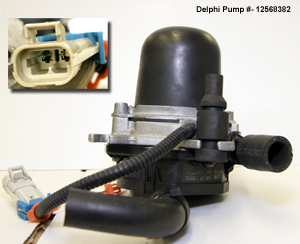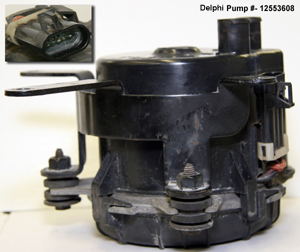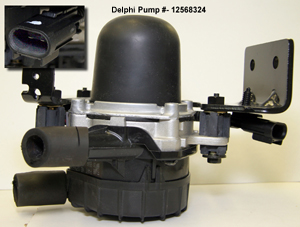A little while back I started doing research on crankcase evac systems because boost pressure in my crankcase was causing me massive oil leaks out of every mating surface.
I found a couple of posts mentioning the LT1 smog pump used as a vacuum pump so I decided to go to the junkyard and pick one up. Luckily someone had already removed one and left it in the passenger seat of a 4th gen Camaro. 5 minutes and 15 dollars later I was on my way.
I looked around for hobbs switches, relays, etc, and after an exhausting search I came to the conclusion that I should have in the beginning. Buy the racetronix harness that is specifically for this purpose. Between driving around, nickel and diming myself on parts, and the hassle of assembly (I guess I'm lazy) I found that the racetronix harness was well worth it.
After some thinking I decided to install it pulling from the passenger side valve cover, to a moisture seperator and then back out a hose to a brass barb fitting I tapped into the inlet pipe to the turbo.
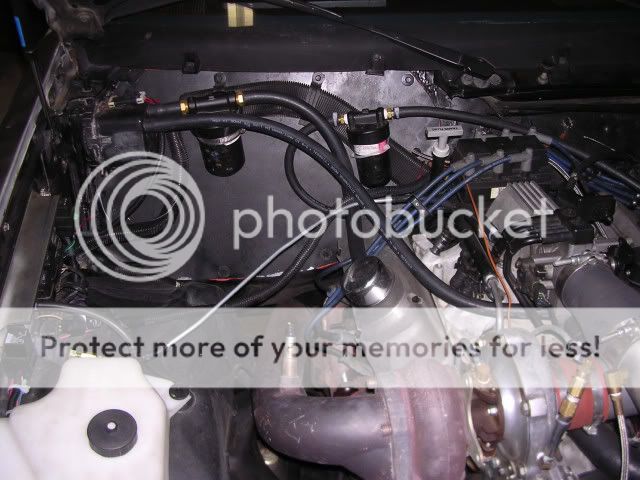
The passenger side is where the pcv is now. I ran a hose from the pcv tube off the vacuum block to a smaller moisture seperator, out to a check valve from a power brake booster and then to the pcv valve in the valve cover.
Note that the check valve from the brake booster doesn't seem to work that well. I will be getting a different style from the hardware store soon.
The moisture seperators are just regular units for a compressed air system like what you would use for a shop.
The reason you have to run the pcv is that this limits the amount of air the engine is pulling from that hose. Without the pcv you have the equivalent of a large vacuum leak. If you completely seal the engine then you will be pulling whatever vacuum on the engine crankcase that the engine intake is seeing. This is too much vacuum. The pcv limits the amount of vacuum you are pulling on the crankcase to prevent this.
When I first tested this set up it did not work well at all. Upon boost I immediately started shooting large amounts of oil everywhere. This subsequently left a huge cloud of smoke in my wake.
Frustrated I did more searching and found that some had dismantled the pump to remove an internal foam filter and check valve. There was also some mention of an internal resistor limiting voltage to the motor. My first attempt was to pull the foam out of the inlet hole on the pump because the adhesive holding the pump was unbelievably strong. This was unsuccessful. Despite removing a lot of foam the pump still did not work well enough.
I then decided that I was going to open this thing up come hell or high water.
To do this I used several razor blades that I would wedge between the housing and the case like this:
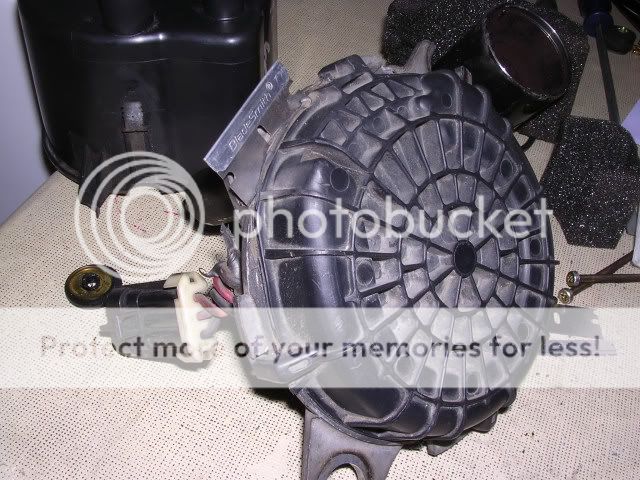
I had to tap a razor down through the adhesive with a small hammer all the way around the housing.
Note that I am removing the impeller side in that photo. I later discovered that this was not necessary. Just the motor side is necessary.
Upon disassembly this is what I found:
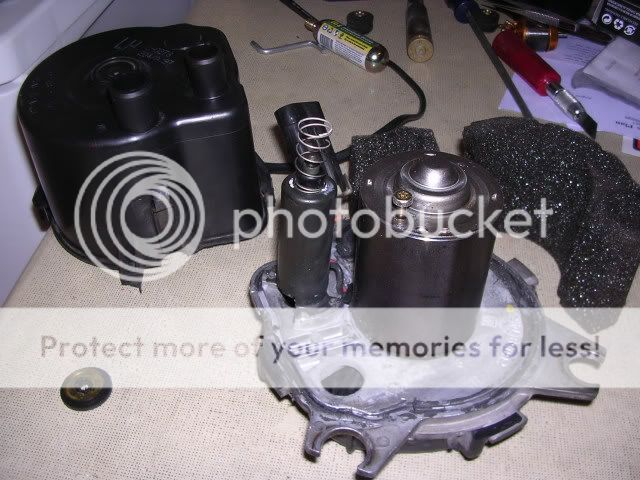
In the background you can see what is left of the foam. It is actually almost twice that size when it is intact. The motor has to work to pull air through that huge thing. Not good.
The cylindrical object on the left with the spring on the end is the check valve. The pintle in the center obstructs air flow out of the outlet side of the pump. The hole that air has to pass through is about the size of a pencil eraser.
There is a small disk with the orifice on the outlet side that you have to tap out (comes out very easily)
here it is:
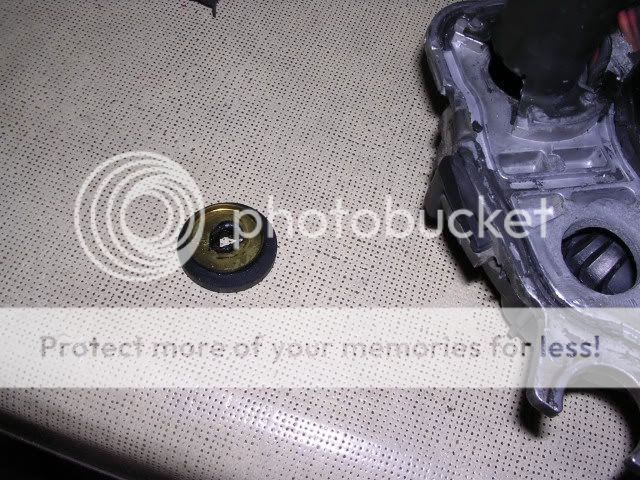
You'll realize at this point that the check valve really serves no purpose for our vacuum pump now. I removed it by cutting the two wires to it and heat shrinking and taping the ends. You will have to use a screwdriver to pop the valve from the aluminum housing. Toss it.
I then went looking for the resistor that I had seen some mention. So I took the can off the motor in the center.
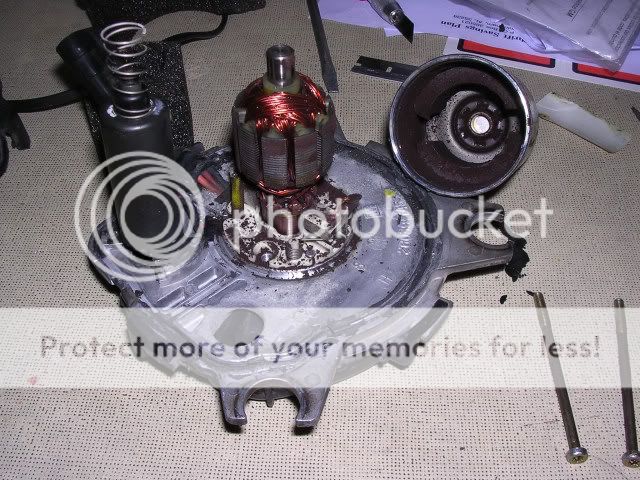
Pretty dirty. No resistor in sight. The wires looked like they traveled to the impeller side of the motor. So I took that all apart. No resistor.
Before reassembly I cleaned the motor and can with alcohol. I then applied a small amount of grease to the upper bushing hole in the can. When operating the motor before I would sometimes hear a loud squeek that I determined was the dry bushing in the motor.
Back in the car..

I retested and now the system worked flawlessly. After a thorough degreasing of the engine bay I found that I now have almost no oil leaks save for a couple small drips from my oil pan and fuel pump block off plate.
This is a vast improvement from before. I used to call my car Slimer because it was so oily.
The moisture seperators are 100% necessary. You should see the stuff that comes out of these. The pcv seperator usually has a mixture of oil, water, and fuel. The seperator to the vacuum pump surprisingly has an essentially completely pure mixture of gasoline and methanol... not even a hint of oil. I was pretty surprised.
This is the stuff thats floating around in your oil if you just run breathers.
All in all, I highly recommend doing this mod on any turbo regal but especially those that run high boost like I do. I have yet to see how much vacuum I am actually pulling on the crank case but it is apparently working in so far as vastly reducing my oil leaks. I shouldn't forget to mention that despite the hugely inaccurate reputation the butt dyno has... the car seemed to pull more smoothly and harder after this mod.
I hope this helps someone. Any questions feel free to ask.
I found a couple of posts mentioning the LT1 smog pump used as a vacuum pump so I decided to go to the junkyard and pick one up. Luckily someone had already removed one and left it in the passenger seat of a 4th gen Camaro. 5 minutes and 15 dollars later I was on my way.
I looked around for hobbs switches, relays, etc, and after an exhausting search I came to the conclusion that I should have in the beginning. Buy the racetronix harness that is specifically for this purpose. Between driving around, nickel and diming myself on parts, and the hassle of assembly (I guess I'm lazy) I found that the racetronix harness was well worth it.
After some thinking I decided to install it pulling from the passenger side valve cover, to a moisture seperator and then back out a hose to a brass barb fitting I tapped into the inlet pipe to the turbo.

The passenger side is where the pcv is now. I ran a hose from the pcv tube off the vacuum block to a smaller moisture seperator, out to a check valve from a power brake booster and then to the pcv valve in the valve cover.
Note that the check valve from the brake booster doesn't seem to work that well. I will be getting a different style from the hardware store soon.
The moisture seperators are just regular units for a compressed air system like what you would use for a shop.
The reason you have to run the pcv is that this limits the amount of air the engine is pulling from that hose. Without the pcv you have the equivalent of a large vacuum leak. If you completely seal the engine then you will be pulling whatever vacuum on the engine crankcase that the engine intake is seeing. This is too much vacuum. The pcv limits the amount of vacuum you are pulling on the crankcase to prevent this.
When I first tested this set up it did not work well at all. Upon boost I immediately started shooting large amounts of oil everywhere. This subsequently left a huge cloud of smoke in my wake.
Frustrated I did more searching and found that some had dismantled the pump to remove an internal foam filter and check valve. There was also some mention of an internal resistor limiting voltage to the motor. My first attempt was to pull the foam out of the inlet hole on the pump because the adhesive holding the pump was unbelievably strong. This was unsuccessful. Despite removing a lot of foam the pump still did not work well enough.
I then decided that I was going to open this thing up come hell or high water.
To do this I used several razor blades that I would wedge between the housing and the case like this:

I had to tap a razor down through the adhesive with a small hammer all the way around the housing.
Note that I am removing the impeller side in that photo. I later discovered that this was not necessary. Just the motor side is necessary.
Upon disassembly this is what I found:

In the background you can see what is left of the foam. It is actually almost twice that size when it is intact. The motor has to work to pull air through that huge thing. Not good.
The cylindrical object on the left with the spring on the end is the check valve. The pintle in the center obstructs air flow out of the outlet side of the pump. The hole that air has to pass through is about the size of a pencil eraser.
There is a small disk with the orifice on the outlet side that you have to tap out (comes out very easily)
here it is:

You'll realize at this point that the check valve really serves no purpose for our vacuum pump now. I removed it by cutting the two wires to it and heat shrinking and taping the ends. You will have to use a screwdriver to pop the valve from the aluminum housing. Toss it.
I then went looking for the resistor that I had seen some mention. So I took the can off the motor in the center.

Pretty dirty. No resistor in sight. The wires looked like they traveled to the impeller side of the motor. So I took that all apart. No resistor.
Before reassembly I cleaned the motor and can with alcohol. I then applied a small amount of grease to the upper bushing hole in the can. When operating the motor before I would sometimes hear a loud squeek that I determined was the dry bushing in the motor.
Back in the car..

I retested and now the system worked flawlessly. After a thorough degreasing of the engine bay I found that I now have almost no oil leaks save for a couple small drips from my oil pan and fuel pump block off plate.
This is a vast improvement from before. I used to call my car Slimer because it was so oily.
The moisture seperators are 100% necessary. You should see the stuff that comes out of these. The pcv seperator usually has a mixture of oil, water, and fuel. The seperator to the vacuum pump surprisingly has an essentially completely pure mixture of gasoline and methanol... not even a hint of oil. I was pretty surprised.
This is the stuff thats floating around in your oil if you just run breathers.
All in all, I highly recommend doing this mod on any turbo regal but especially those that run high boost like I do. I have yet to see how much vacuum I am actually pulling on the crank case but it is apparently working in so far as vastly reducing my oil leaks. I shouldn't forget to mention that despite the hugely inaccurate reputation the butt dyno has... the car seemed to pull more smoothly and harder after this mod.
I hope this helps someone. Any questions feel free to ask.

